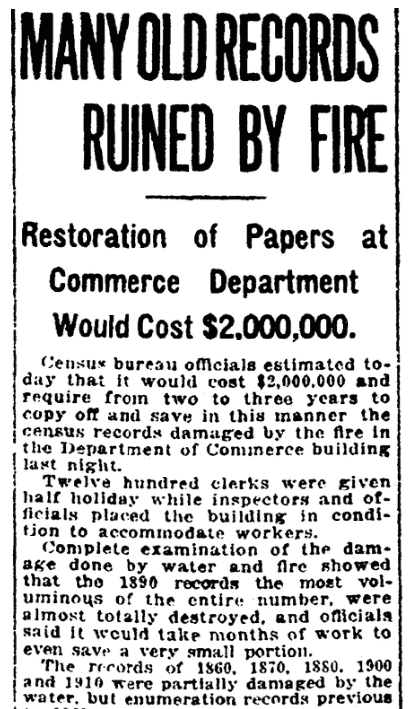Introduction: In this article – part of an ongoing “Introduction to Genealogy” series – Gena Philibert-Ortega describes how genealogists can get around the fact that most of the 1890 census was lost in the 1921 Commerce Department building fire. Gena is a genealogist and author of the book “From the Family Kitchen.”
You’ve probably heard the laments online, or heard a fellow researcher complain, that if only they had access to the “lost” 1890 U.S. Federal Census they could solve their family history research problem. There’s no doubt that we rely on the decennial census – and having that gap can be frustrating, especially since so much can happen to our families in the span of 10 years including births, deaths, remarriages, and moves. However, it’s important to remember that not having that census isn’t the end of the world.
The 1890 U.S. Federal Census
If you’re new to genealogy you may not be aware that the 1890 U.S. Federal Census was all but lost in the 1921 Commerce Department building fire in Washington, D.C. Not everything was lost – but enough was destroyed that it impacts the majority of family history researchers.

According to the National Archives website, what survived includes:
- Some general population census schedules
- Schedules of Union Civil War Veterans or their widows
- Oklahoma territorial schedules
- List of selected Delaware African Americans
- Statistics of Lutheran congregations
- Statistical information for the entire United States (1)
The general population schedules that were not destroyed enumerate approximately 6,160 people in portions of 10 states and the District of Columbia. For a specific list of those surviving schedules see the National Archives 1890 web page.
For the lucky researcher who can still find family in the 1890 census, the questions on that census include:
- Name of the individual
- Whether a soldier, sailor, or marine in the Civil War
- Relationship to head of family
- Race, sex, and age
- Marital status
- Mother of how many children, how many living
- Place of birth for the person, their father and mother
- Naturalization status
- Occupation
- Months unemployed
- Attendance at school
- Able to read/write/speak English
- Whether suffering from acute or chronic illness
- Whether defective in mind, sight, hearing, speech, or whether crippled, maimed, or deformed, with name of defect
- Whether a prisoner, convict, homeless child, or pauper (2)
You can conduct a search on what records remain of the 1890 census in GenealogyBank’s U.S. Federal Census collection.
There’s Still Hope: Substitutions
So, what do we do since, for most of us, the 1890 census doesn’t exist? You’ll come across many cases of missing, illegible, and destroyed records in your genealogical research journey. The solution to this problem is identifying other records created during that time and place. We rely heavily on censuses because they document your ancestor in a specific place and time. But there are other records that also do that for the 1890s decade, including:
- 1890 Veterans Schedule. Remember that not all of the 1890 census records were destroyed in the fire. The Veterans Schedule is available and you can learn more about it in my article: Genealogy 101: The 1890 Veterans Schedule.
- State Censuses. Your ancestor may have lived in a state where a state census was taken in 1885 or 1895. The FamilySearch Research Wiki lists what states conducted censuses. You can learn more about state censuses in my article: Genealogy 101: The State Census.
- City Directories. Available at libraries and online digitized book websites. Check out the directories for the years leading up to 1890 and the subsequent years.
- Tax Lists. People paid taxes and that record helps put at least the head of household in a specific place in time.
- Newspapers, such as GenealogyBank’s Historical Newspaper Archives, record all types of genealogically-relevant information including vital record events. Don’t forget about the possibilities of a mention in delinquent tax lists and legal notices routinely published in newspapers.
No 1890 Census? So What!
Not having access to the 1890 U.S. Federal Census is not the end of the world. Is it an inconvenience? Yes. But it’s probably not going to be the only missing record you will encounter in your genealogical research. The one thing to keep in mind is to seek out records for your ancestor’s time and place. Don’t forget to use resources like historical newspapers to provide information about your ancestor’s life.
_______________
(1) “1890 Census,” National Archives (https://www.archives.gov/research/census/1890: accessed 3 October 2019).
(2) “1890 United States Census,” Wikipedia (https://en.wikipedia.org/wiki/1890_United_States_Census: accessed 3 October 2019).
